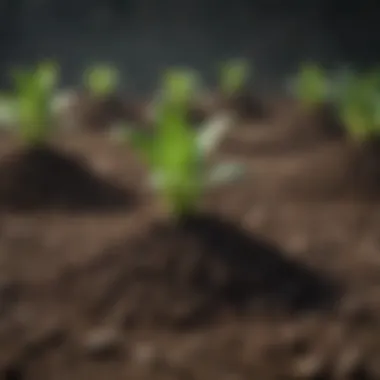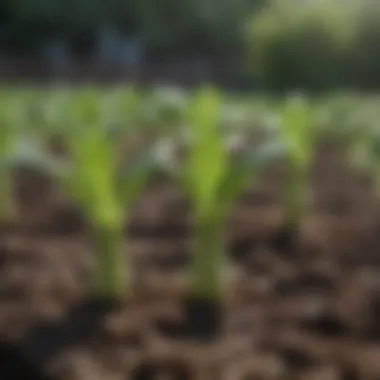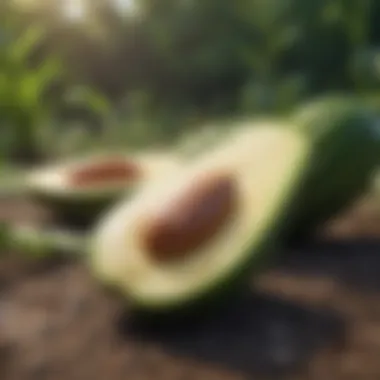Ultimate Guide to Cultivating Zucchini Successfully


Intro
Growing zucchini plants is a rewarding endeavor for gardeners of all skill levels. Zucchini, a summer squash, can thrive in various conditions, making them accessible. This guide will provide a structured approach to all aspects of zucchini cultivation, from soil preparation to pest control.
Soil Preparation
Before planting, it is essential to prepare the soil adequately. Zucchini prefers well-drained, nutrient-rich soil with a pH level between 6.0 and 7.5. Here are key steps to prepare your soil:
- Choose the Right Location: Zucchini plants need full sun, so select a spot that receives at least six to eight hours of sunlight daily.
- Soil Testing: Conduct a soil test to determine nutrient levels and pH. This can guide you in amending the soil as needed.
- Enrich the Soil: Add organic matter, like compost or well-rotted manure, to improve drainage and fertility.
Planting Techniques
Once the soil is prepared, it's time to plant. Zucchini can be sowed directly in the ground or started indoors and transplanted later. Here are tips:
- Timing: Plant zucchini seeds after the last frost date, when soil temperatures reach at least 70°F (21°C).
- Spacing: Space seeds about 36 inches apart in rows that are 4 to 6 feet apart. Proper spacing ensures good airflow and sunlight exposure.
- Depth: Sow seeds about one inch deep for optimal germination.
Care Requirements
Zucchini plants require regular care to thrive. Consider these essential care tips:
- Watering: Water regularly, ensuring the soil remains consistently moist but not soggy. Early morning is the best time to water, if possible.
- Fertilization: Use a balanced fertilizer every few weeks. High phosphorus fertilizers can help support blooming and fruiting.
- Mulching: Apply mulch around plants to help retain moisture, suppress weeds, and regulate soil temperature.
Pest Management
Pest control is vital to successful zucchini cultivation. Here are common pests and management strategies:
- Squash Bugs: These pests can damage leaves. Hand-picking them or using insecticidal soap can help manage their populations.
- Cucumber Beetles: These may cause significant harm. Employ row covers to protect young plants.
- Powdery Mildew: A fungal disease that affects the leaves. Ensure proper spacing for airflow and apply fungicides if necessary.
Effective pest management combines prevention and chemical controls where needed. Regular monitoring is key to identifying problems early.
Harvesting
Zucchini is typically ready for harvest in 6 to 8 weeks after planting. Consider the following when harvesting:
- Size: Ideal zucchini size is 6 to 8 inches long. Smaller zucchinis are more tender.
- Technique: Use a sharp knife or scissors to cut the zucchini, leaving a short stem attached to the fruit.
Ending
Prelude to Zucchini Cultivation
Zucchini, a member of the squash family, is cultivated worldwide for its versatile fruits and robust growing characteristics. As more people seek to grow their own food, understanding the fundamentals of zucchini cultivation becomes essential. This section introduces the key considerations of growing zucchini and highlights its relevance in sustainable gardening practices.
Growing zucchini is not only rewarding but also practical. Its capability to thrive in various climates makes it a favorite among gardeners. Zucchini contributes significantly to local food security as it provides a nutritious addition to diets. Its growth is relatively fast, allowing for multiple harvests in a single growing season.
A few important benefits of cultivating zucchini include:
- Nutritional Value: Zucchini is low in calories and high in vitamins A and C, making it an excellent choice for health-conscious individuals.
- Space Efficiency: Zucchini plants can be grown vertically if space is limited, making them suitable for small gardens or container gardening.
- Diversity in Cooking: The versatility of zucchini allows it to be incorporated into a wide range of dishes, from salads to baked goods.
However, there are considerations that new gardeners should be mindful of. Zucchini is susceptible to certain pests and diseases, which can adversely affect yield. Understanding these challenges and learning proactive management techniques is crucial for success. Moreover, proper soil preparation and timing for planting are critical factors in achieving a healthy crop.
"A successful zucchini garden starts with knowledge of its needs, from soil requirements to harvesting practices."
In summary, this introduction establishes that zucchini cultivation is an accessible and beneficial endeavor. Preparing to grow zucchini entails understanding its characteristics, selecting the right environment, and implementing best practices throughout the growing season. This foundational knowledge sets the stage for all subsequent sections, ensuring that both novice and experienced gardeners can navigate the nuances of this rewarding crop.
Understanding the Zucchini Plant
Understanding the zucchini plant is essential to successful cultivation. This section focuses on key botanical aspects and the various growing habits of zucchini. Zucchini, a member of the cucurbit family, has specific characteristics that determine its growth and yield. Recognizing these traits allows gardeners to make informed decisions during the cultivation process. Moreover, understanding the different types of zucchini can help in selecting the most suitable varieties for one’s garden.
Botanical Characteristics
The zucchini plant, scientifically named Cucurbita pepo, exhibits unique botanical traits. Typically, it features large, dark green leaves with a rough texture, which provide shade and protection to the developing fruit. The flowers are bright yellow and are crucial for fertilization, as they attract necessary pollinators.
Zucchini plants spread out and can grow quite large, often reaching several feet in diameter. The stems are thick and sturdy, supporting the weight of the fruit. The fruit itself is usually elongated with smooth skin, traditionally green, but can also appear in yellow or striped varieties. Plant characteristics significantly influence how the zucchini will perform in different environments and help gardeners tailor their care practices.


Growing Habits and Types of Zucchini
Zucchini generally thrives in warm climates and can be grown in various conditions, from small containers to expansive gardens. The plant has a prostrate growing habit, which means it tends to spread horizontally, often resting on the ground. This growth pattern necessitates spatial consideration to ensure proper sunlight and air circulation.
There are several common types of zucchini, including:
- Dark Green Zucchini: This is the most recognizable type, widely cultivated for its firm texture and mild flavor.
- Crookneck Zucchini: This variety has a distinctive neck that curves and is often yellow, adding to its visual appeal.
- Striped Zucchini: This type has a unique striped pattern, which some gardeners prefer for aesthetic reasons.
Choosing the right type of zucchini can depend on personal preference as well as local climate conditions. Each type has its unique flavor profile and can be used differently in cooking. Understanding these aspects aids in making optimal growing decisions that can lead to a successful harvest.
Preparing for Planting
Preparing for planting is a crucial stage in the journey of growing zucchini. This phase differs from the actual planting as it lays the groundwork for a successful crop. Factors like location, soil, and timing play pivotal roles in determining the health and yield of zucchini plants. A well-prepared garden not only enhances plant growth but also minimizes potential challenges.
Selecting the Right Location
Location is often an underestimated factor in plant health. Zucchini thrives in full sunlight, so selecting a spot that receives at least six to eight hours of direct sunshine daily is highly advisable. This sunlight fuels the process of photosynthesis, which is essential for the plant’s growth.
Additionally, the chosen location should have good air circulation and drainage. Stagnant air can lead to fungal diseases, which zucchini plants are particularly susceptible to. Furthermore, proximity to other plants matters. Avoid areas where other squash types were grown in the previous season. This helps prevent soil-borne diseases.
Soil Requirements
Soil Type
The type of soil you choose influences plant growth significantly. Zucchini prefers well-draining, loamy soil. Loamy soil consists of a balance between clay, silt, and sand. It retains moisture without becoming waterlogged.
A key characteristic of loamy soil is its nutrient-rich composition. This richness contributes to better plant health and optimal yield. However, heavy clay soil or overly sandy soil can hinder growth due to poor water retention or drainage.
Soil pH
Soil pH is another vital factor for zucchini. A slightly acidic to neutral pH, between 6.0 and 7.5, is ideal. This range allows for maximum nutrient availability.
One notable feature is how pH impacts seed germination and root development. If the pH is too low or too high, it may lead to nutrient deficiencies, which affect overall plant health. Testing the soil pH before planting can save a lot of trouble later.
Soil Amendments
Soil amendments improve soil structure, fertility, and overall plant health. Common amendments include compost, well-rotted manure, and peat moss. These materials add organic matter, enhancing moisture retention and nutrient content.
A distinct advantage of using amendments is how they can help balance pH levels. If you encounter acidic soil, adding lime can elevate pH. Conversely, sulfur can lower it if the soil is too alkaline. Thus, properly amending the soil is a critical step for optimal zucchini growth.
Timing for Planting
Timing is essential when planting zucchini. Generally, they should be planted after the last frost when soil temperatures reach at least 60°F (15°C). This ensures seeds germinate effectively.
Planting too early in cold soil can lead to poor germination and increases the risk of disease. Monitoring weather conditions and soil temperature before planting is wise. If the spring is particularly cold, consider starting seeds indoors to transplant them later.
"A well-prepared garden is half the battle won."
Planting Zucchini
Planting zucchini is a critical stage in the cultivation process. Proper planting techniques can significantly influence the growth and yield of zucchini. Knowing when and how to plant can lead to healthier plants and a more fruitful harvest. This section walks through essential elements of planting zucchini, including contrasting methods and guidelines.
Direct Seeding vs.
Transplanting
There are two primary methods for establishing zucchini in your garden: direct seeding and transplanting. Each has its own set advantages and disadvantages.
- Direct Seeding involves sowing seeds straight into the soil. This method is simpler and less labor-intensive. Zucchini seeds germinate quickly, often in just a week under optimal conditions. However, this method has its risks, such as susceptibility to pests and weather conditions.
- Transplanting means starting seeds in an indoor environment or greenhouse, then moving them outdoors when conditions are right. This approach allows for a longer growing season. It also can give the plants a head start against pests. Unfortunately, it requires more effort and planning. Seedlings can be sensitive to shock during the transition.
Both methods have merit. Direct seeding is straightforward and cost-effective, while transplanting offers better control over initial growth conditions. The decision should reflect personal gardening preferences and local conditions.
Spacing and Depth Guidelines


Proper spacing and depth play a vital role in the planting process. These factors can affect air circulation, light exposure, and nutrient availability within the garden.
- Spacing: Zucchini plants require adequate room to grow. Generally, space plants 24 to 36 inches apart. This distance allows each plant to spread its leaves and avoids crowding, which can lead to diseases.
- Depth: Plant zucchini seeds at a depth of about 1 inch. For seedlings, make sure the root ball is underground but the leaves are above the soil line. This encourages healthy growth and supports strong stems.
Following these guidelines provides the best conditions for thriving zucchini plants. Consider the growth habit of the specific variety chosen, as some may require more space than others. Adjustments may be necessary depending on environmental factors or specific gardening goals.
A well-planned planting strategy enhances not only plant health but also ultimately the yield quality and quantity.
Understanding these techniques will help gardeners of all experience levels create a productive zucchini crop.
Caring for Zucchini Plants
Caring for zucchini plants is a crucial aspect of cultivation that directly influences the health and yield of your crop. Proper care practices ensure that plants receive the necessary nutrients, water, and attention needed to thrive. This section will delve into essential care elements, focusing specifically on watering techniques, fertilization practices, and pruning and maintenance.
Watering Techniques
Watering is vital for zucchini plants. Adequate water helps to sustain growth and supports the development of juicy fruits. It is best to water zucchini deeply and less frequently rather than shallowly and often. This method encourages deep root growth, making plants more resilient in dry conditions. Usually, a consistent schedule of watering every 3 to 4 days is effective, especially during hot weather.
One effective irrigation method is to use drip hoses or soaker hoses. This approach minimizes water evaporation and delivers moisture directly to the root zone. Watering early in the morning avoids fungal diseases, as the foliage dries quickly. Check the soil moisture regularly. If the top two inches of soil are dry, it is time to water again.
Fertilization Practices
Fertilization is a key factor that cannot be overlooked. Zucchini plants require ample nutrients to grow strong and produce abundantly. Proper fertilization leads to healthier plants, less susceptibility to diseases, and higher yields.
Types of Fertilizers
When considering fertilizers for zucchini, both organic and synthetik options are available. Organic options like compost or well-rotted manure provide essential nutrients as well as improve soil structure over time. Synthetic fertilizers, such as a balanced 10-10-10 NPK, are also effective. They provide quick nutrient availability but should be used with caution to prevent excess nitrogen, which can lead to rapid growth at the expense of fruit development.
Each type has its own benefits. Organic fertilizers feed the soil, fostering a healthy ecosystem. Synthetic fertilizers, on the other hand, provide immediate nutrient availability, important for rapid growth phases. Knowing which fertilizer to use based on your soil conditions is essential.
Application Frequency
The frequency of fertilizer application is also significant. A general rule of thumb is to fertilize zucchini plants once every 4 to 6 weeks throughout the growing season. Early in the growth phase, emphasizing nitrogen can encourage leaf and stem growth. As the plants mature, shifting to a fertilizer higher in phosphorous and potassium supports flowering and fruiting. Consistent monitoring of plant health can provide indications of when to apply fertilizer. Lack of growth or yellowing leaves may signal a need for nourishment.
Pruning and Maintenance
Pruning plays an important role in maintaining the health of zucchini plants. Regular pruning allows for better air circulation and sunlight penetration, which can reduce the risk of fungal diseases and promote fruit development. It is often recommended to remove any dead or yellowing leaves, as these can draw energy away from healthy parts of the plant. Additionally, removing some lateral shoots can help to direct the plant's energy into fruit production rather than excess foliage.
In summary, taking the time to care for zucchini plants through proper watering, fertilizing, and maintenance practices significantly enhances their growth potential and yields. This investment in care ensures a productive harvest and contributes to the overall success of the zucchini cultivation process.
Pest and Disease Management
Managing pests and diseases is vital for successful zucchini cultivation. A balanced approach keeps crops healthy and maximizes yield. Understanding pest behavior and diseases helps gardeners reduce risks and maintain plant vigor. Failing to manage these threats can lead to significant loss. This section explores common pests, preventive measures, and effective treatment options for zucchini plants.
Common Pests Affecting Zucchini
Zucchini plants can be affected by various pests that may hinder their growth. Common pests include:
- Aphids: These small insects feed on plant sap. They weaken the plant and may spread diseases.
- Squash Bugs: They can cause leaves to wilt and become yellow, leading to potential plant death.
- Cucumber Beetles: Known for feeding on leaves, they also spread bacterial wilt, harming zucchini plants.
- Spider Mites: These tiny arachnids can create fine webs on plants and cause leaf discoloration and stress.
These pests can appear quickly and cause substantial damage if not managed properly. Regular monitoring is essential to detect problems early.
Preventive Measures
Preventive measures are crucial in managing pests effectively. Adopting a proactive strategy reduces the likelihood of infestations. Here are some strategies to consider:
- Crop Rotation: Change plant locations each year to disrupt pest life cycles. This reduces pest populations.
- Companion Planting: Some plants repel pests. For instance, planting marigolds alongside zucchini can deter aphids and nematodes.
- Regular Monitoring: Check plants frequently for signs of pests or disease. Early detection enables swift action.
- Healthy Practices: Maintain proper watering and fertilization. Strong plants resist pests better.
By implementing these measures, gardeners can effectively minimize pest impact and support healthy zucchini growth.
Organic and Chemical Treatments
If preventive measures fail, it's crucial to recognize effective treatment options. These include organic and chemical treatments:


Organic Treatments
- Neem Oil: This natural pesticide disrupts the life cycle of many pests and is safe for beneficial insects when applied correctly.
- Insecticidal Soap: It targets soft-bodied insects like aphids and spider mites, providing a good organic solution.
- Diatomaceous Earth: Sprinkling this powder can deter crawling insects. It damages their exoskeletons without harming plants.
Chemical Treatments
In certain cases, chemical treatments may be necessary.
- Pyrethrin-based Insecticides: Derived from chrysanthemums, these are effective against many pests.
- Synthetic Pesticides: Use these only when necessary and according to label instructions. Consider the impact on the environment and beneficial insects.
Always read labels and follow guidelines for safety. The emphasis should remain on the least harmful options, balancing effectiveness and ecological impact.
Effective pest management involves understanding pest behaviors and identifying the right control measures to protect zucchini plants without harming beneficial organisms.
Harvesting Zucchini
Harvesting zucchini is a crucial step in the cultivation process that directly impacts the quality and yield of your crop. Picking zucchinis at the right time ensures optimal taste and texture. Delay in harvesting can lead to larger fruits that are tougher and less flavorful, while premature harvesting may result in smaller, less developed vegetables. Recognizing the right moment to harvest can make a significant difference.
Signs of Ripeness
The signs of ripeness for zucchini are relatively straightforward. Generally, zucchinis are ready to harvest when they reach a size of about 6 to 8 inches in length. At this stage, they are tender and have thin skin, making them pleasant to eat. Here are a few more indicators to determine if zucchinis are ripe:
- Color: The skin should display a consistent green or yellow color, depending on the variety. Avoid zucchinis with dull or faded skin.
- Firmness: Gently squeeze the zucchini. It should feel firm but not hard. If it's soft, it may be overripe.
- Blossom End: Check the blossom end. It should be plump and not shriveled.
It is best to inspect the plants every couple of days during peak growing seasons to ensure you do not miss the perfect harvesting moment.
Harvesting Techniques
Proper harvesting techniques are essential to minimize damage to the plant and ensure the best results. Here are some effective methods for harvesting zucchini:
- Use of Shears: Always use garden shears or scissors when cutting zucchinis from the plant. This prevents tearing or damaging the stem.
- Cut Close to the Stem: Aim to cut the zucchini close to the stem but leave a small portion attached to minimize potential rot.
- Handle with Care: After cutting, handle the fruits gently to avoid bruising. Store them in a cool place right after harvesting.
Keeping these techniques in mind will help you achieve an efficient and effective harvesting process, allowing you to enjoy the fruits of your labor in cooking and meal preparation.
"Harvesting at the right time not only enhances the flavor but also promotes further growth of the plant."
When done correctly, harvesting zucchini can lead to a sustained supply, as continuous harvesting can encourage the plant to produce more fruit. Always remember, the sooner you harvest, the better the flavor and quality will be.
Post-Harvest Handling
Post-harvest handling is a crucial stage in the zucchini cultivation process. It involves the techniques and practices that gardeners use to preserve and maximize the quality of zucchini after harvesting. Proper post-harvest methods can significantly improve the shelf life, nutritional value, and culinary versatility of the produce. Understanding this aspect helps to ensure that the hard work put into growing zucchini is rewarded with the best possible yield.
Storage Practices
Storing zucchini correctly is essential to maintain its flavor and freshness. Here are some best practices for storage:
- Temperature: Zucchini should be stored at a cool temperature, ideally between 45°F to 50°F (7°C to 10°C). Avoid exposure to temperatures below 50°F (10°C) as it may cause chilling injury, which affects texture and flavor.
- Humidity: Keep zucchini in a humid environment to prevent dehydration. A plastic bag with small holes can maintain humidity while allowing airflow.
- Duration: Properly stored, zucchini can last about one to two weeks. Check them regularly for signs of spoilage and remove any damaged pieces to prevent spreading rot.
Tip: Do not wash zucchinis before storage. Washing adds moisture, which can accelerate spoilage.
Using Zucchini in Cooking
Zucchini is well-regarded for its versatility in the kitchen. It can be prepared in various ways, suited for different cuisines and dietary preferences. Here are some common methods of using zucchini:
- Raw in Salads: Slicing zucchini thinly and incorporating it into salads can provide a healthy crunch.
- Grilling: Grilled zucchini adds a smoky flavor and can be a great side dish or topping for sandwiches and burgers.
- Baking: Zucchini can be incorporated into baked goods like breads and muffins, adding moisture and nutritional content without overpowering the dish.
- Soups and Stews: Adding zucchini pieces into soups and stews infuses a subtle flavor and enhances nutrition.
Advantages: Including zucchini in meals is beneficial due to its low calories and high fiber content. It serves as a fantastic base to absorb flavors from spices and sauces.
End
The conclusion of this guide serves as a vital summary, reinforcing the key takeaways essential for successful zucchini cultivation. Growing zucchini is not merely about planting seeds; it encompasses an entire cycle that begins with understanding the plant’s requirements and ends with proper post-harvest management.
A few important points to consider include:
- Preparation: Effective soil preparation and selection of a suitable location form the foundation for healthy zucchini plants.
- Care: Regular watering, fertilization, and pruning practices are critical to ensure robust growth and yield.
- Management: Awareness of pests and diseases can save your plants, as prevention and timely interventions make a notable difference.
- Harvesting: Knowing when and how to harvest ensures not only the best flavor but also encourages continuous production.
Taking the steps discussed in this article can lead to a fruitful zucchini harvest. The processes may seem daunting, but understanding each element demystifies zucchini gardening. Emphasis on careful observation and adaptability during the growing season will enhance your chances for success.
"Gardening is a way of giving back to nature the gratitude for its bounty."







